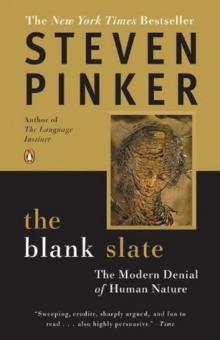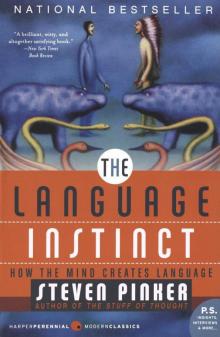- Home
- Steven Pinker
The Language Instinct: How the Mind Creates Language Page 3
The Language Instinct: How the Mind Creates Language Read online
Page 3
But though the language engine is invisible to the human user, the trim packages and color schemes are attended to obsessively. Trifling differences between the dialect of the mainstream and the dialect of other groups, like isn’t any versus ain’t no, those books versus them books, and dragged him away versus drug him away, are dignified as badges of “proper grammar.” But they have no more to do with grammatical sophistication than the fact that people in some regions of the United States refer to a certain insect as a dragonfly and people in other regions refer to it as a darning needle, or that English speakers call canines dogs whereas French speakers call them chiens. It is even a bit misleading to call Standard English a “language” and these variations “dialects,” as if there were some meaningful difference between them. The best definition comes from the linguist Max Weinreich: a language is a dialect with an army and a navy.
The myth that nonstandard dialects of English are grammatically deficient is widespread. In the 1960s some well-meaning educational psychologists announced that American black children had been so culturally deprived that they lacked true language and were confined instead to a “non-logical mode of expressive behavior.” The conclusions were based on the students’ shy or sullen reactions to batteries of standardized tests. If the psychologists had listened to spontaneous conversations, they would have rediscovered the commonplace fact that American black culture is everywhere highly verbal; the subculture of street youths in particular is famous in the annals of anthropology for the value placed on linguistic virtuosity. Here is an example, from an interview conducted by the linguist William Labov on a stoop in Harlem. The interviewee is Larry, the roughest member of a teenage gang called the Jets. (Labov observes in his scholarly article that “for most readers of this paper, first contact with Larry would produce some fairly negative reactions on both sides.”)
You know, like some people say if you’re good an’ shit, your spirit goin’ t’heaven…’n’ if you bad, your spirit goin’ to hell. Well, bullshit! Your spirit goin’ to hell anyway, good or bad.
[Why?]
Why? I’ll tell you why. ’Cause, you see, doesn’ nobody really know that it’s a God, y’know, ’cause I mean I have seen black gods, white gods, all color gods, and don’t nobody know it’s really a God. An’ when they be sayin’ if you good, you goin’ t’heaven, that’s bullshit, ’cause you ain’t goin’ to no heaven, ’cause it ain’t no heaven for you to go to.
[…jus’ suppose that there is a God, would he be white or black?]
He’d be white, man.
[Why?]
Why? I’ll tell you why. ’Cause the average whitey out here got everything, you dig? And the nigger ain’t got shit, y’know? Y’understan’? So—um—for—in order for that to happen, you know it ain’t no black God that’s doin’ that bullshit.
First contact with Larry’s grammar may produce negative reactions as well, but to a linguist it punctiliously conforms to the rules of the dialect called Black English Vernacular (BEV). The most linguistically interesting thing about the dialect is how linguistically uninteresting it is: if Labov did not have to call attention to it to debunk the claim that ghetto children lack true linguistic competence, it would have been filed away as just another language. Where Standard American English (SAE) uses there as a meaningless dummy subject for the copula, BEV uses it as a meaningless dummy subject for the copula (compare SAE’s There’s really a God with Larry’s It’s really a God). Larry’s negative concord (You ain’t goin’ to no heaven) is seen in many languages, such as French (ne…pas). Like speakers of SAE, Larry inverts subjects and auxiliaries in nondeclarative sentences, but the exact set of the sentence types allowing inversion differs slightly. Larry and other BEV speakers invert subjects and auxiliaries in negative main clauses like Don’t nobody know; SAE speakers invert them only in questions like Doesn’t anybody know? and a few other sentence types. BEV allows its speakers the option of deleting copulas (If you bad); this is not random laziness but a systematic rule that is virtually identical to the contraction rule in SAE that reduces He is to He’s, You are to You’re, and I am to I’m. In both dialects, be can erode only in certain kinds of sentences. No SAE speaker would try the following contractions:
Yes he is! Yes he’s!
I don’t care what you are. I don’t care what you’re.
Who is it? Who’s it?
For the same reasons, no BEV speaker would try the following deletions:
Yes he is! Yes he!
I don’t care what you are. I don’t care what you.
Who is it? Who it?
Note, too, that BEV speakers are not just more prone to eroding words. BEV speakers use the full forms of certain auxiliaries (I have seen), whereas SAE speakers usually contract them (I’ve seen). And as we would expect from comparisons between languages, there are areas in which BEV is more precise than standard English. He be working means that he generally works, perhaps that he has a regular job; He working means only that he is working at the moment that the sentence is uttered. In SAE, He is working fails to make that distinction. Moreover, sentences like In order for that to happen, you know it ain’t no black God that’s doin’ that bullshit show that Larry’s speech uses the full inventory of grammatical paraphernalia that computer scientists struggle unsuccessfully to duplicate (relative clauses, complement structures, clause subordination, and so on), not to mention some fairly sophisticated theological argumentation.
Another project of Labov’s involved tabulating the percentage of grammatical sentences in tape recordings of speech in a variety of social classes and social settings. “Grammatical,” for these purposes, means “well-formed according to consistent rules in the dialect of the speakers.” For example, if a speaker asked the question Where are you going?, the respondent would not be penalized for answering To the store, even though it is in some sense not a complete sentence. Such ellipses are obviously part of the grammar of conversational English; the alternative, I am going to the store, sounds stilted and is almost never used. “Ungrammatical” sentences, by this definition, include randomly broken-off sentence fragments, tongue-tied hemming and hawing, slips of the tongue, and other forms of word salad. The results of Labov’s tabulation are enlightening. The great majority of sentences were grammatical, especially in casual speech, with higher percentages of grammatical sentences in working-class speech than in middle-class speech. The highest percentage of ungrammatical sentences was found in the proceedings of learned academic conferences.
The ubiquity of complex language among human beings is a gripping discovery and, for many observers, compelling proof that language is innate. But to tough-minded skeptics like the philosopher Hilary Putnam, it is no proof at all. Not everything that is universal is innate. Just as travelers in previous decades never encountered a tribe without a language, nowadays anthropologists have trouble finding a people beyond the reach of VCR’s, Coca-Cola, and Bart Simpson T-shirts. Language was universal before Coca-Cola was, but then, language is more useful than Coca-Cola. It is more like eating with one’s hands rather than one’s feet, which is also universal, but we need not invoke a special hand-to-mouth instinct to explain why. Language is invaluable for all the activities of daily living in a community of people: preparing food and shelter, loving, arguing, negotiating, teaching. Necessity being the mother of invention, language could have been invented by resourceful people a number of times long ago. (Perhaps, as Lily Tomlin said, man invented language to satisfy his deep need to complain.) Universal grammar would simply reflect the universal exigencies of human experience and the universal limitations on human information processing. All languages have words for “water” and “foot” because all people need to refer to water and feet; no language has a word a million syllables long because no person would have time to say it. Once invented, language would entrench itself within a culture as parents taught their children and children imitated their parents. From cultures that had language, it would spread like wild
fire to other, quieter cultures. At the heart of this process is wondrously flexible human intelligence, with its general multipurpose learning strategies.
So the universality of language does not lead to an innate language instinct as night follows day. To convince you that there is a language instinct, I will have to fill in an argument that leads from the jabbering of modern peoples to the putative genes for grammar. The crucial intervening steps come from my own professional specialty, the study of language development in children. The crux of the argument is that complex language is universal because children actually reinvent it, generation after generation—not because they are taught, not because they are generally smart, not because it is useful to them, but because they just can’t help it. Let me now take you down this trail of evidence.
The trail begins with the study of how the particular languages we find in the world today arose. Here, one would think, linguistics runs into the problem of any historical science: no one recorded the crucial events at the time they happened. Although historical linguists can trace modern complex languages back to earlier ones, this just pushes the problem back a step; we need to see how people create a complex language from scratch. Amazingly, we can.
The first cases were wrung from two of the more sorrowful episodes of world history, the Atlantic slave trade and indentured servitude in the South Pacific. Perhaps mindful of the Tower of Babel, some of the masters of tobacco, cotton, coffee, and sugar plantations deliberately mixed slaves and laborers from different language backgrounds; others preferred specific ethnicities but had to accept mixtures because that was all that was available. When speakers of different languages have to communicate to carry out practical tasks but do not have the opportunity to learn one another’s languages, they develop a makeshift jargon called a pidgin. Pidgins are choppy strings of words borrowed from the language of the colonizers or plantation owners, highly variable in order and with little in the way of grammar. Sometimes a pidgin can become a lingua franca and gradually increase in complexity over decades, as in the “Pidgin English” of the modern South Pacific. (Prince Philip was delighted to learn on a visit to New Guinea that he is referred to in that language as fella belong Mrs. Queen.)
But the linguist Derek Bickerton has presented evidence that in many cases a pidgin can be transmuted into a full complex language in one fell swoop: all it takes is for a group of children to be exposed to the pidgin at the age when they acquire their mother tongue. That happened, Bickerton has argued, when children were isolated from their parents and were tended collectively by a worker who spoke to them in the pidgin. Not content to reproduce the fragmentary word strings, the children injected grammatical complexity where none existed before, resulting in a brand-new, richly expressive language. The language that results when children make a pidgin their native tongue is called a creole.
Bickerton’s main evidence comes from a unique historical circumstance. Though the slave plantations that spawned most creoles are, fortunately, a thing of the remote past, one episode of creolization occurred recently enough for us to study its principal players. Just before the turn of the century there was a boom in Hawaiian sugar plantations, whose demands for labor quickly outstripped the native pool. Workers were brought in from China, Japan, Korea, Portugal, the Philippines, and Puerto Rico, and a pidgin quickly developed. Many of the immigrant laborers who first developed that pidgin were alive when Bickerton interviewed them in the 1970s. Here are some typical examples of their speech:
Me capé buy, me check make.
Building—high place—wall pat—time—nowtime—an’ den—a new tempecha eri time show you.
Good, dis one. Kaukau any-kin’ dis one. Pilipine islan’ no good. No mo money.
From the individual words and the context, it was possible for the listener to infer that the first speaker, a ninety-two-year-old Japanese immigrant talking about his earlier days as a coffee farmer, was trying to say “He bought my coffee; he made me out a check.” But the utterance itself could just as easily have meant “I bought coffee; I made him out a check,” which would have been appropriate if he had been referring to his current situation as a store owner. The second speaker, another elderly Japanese immigrant, had been introduced to the wonders of civilization in Los Angeles by one of his many children, and was saying that there was an electric sign high up on the wall of the building which displayed the time and temperature. The third speaker, a sixty-nine-year-old Filipino, was saying “It’s better here than in the Philippines; here you can get all kinds of food, but over there there isn’t any money to buy food with.” (One of the kinds of food was “pfrawg,” which he caught for himself in the marshes by the method of “kank da head.”) In all these cases, the speaker’s intentions had to be filled in by the listener. The pidgin did not offer the speakers the ordinary grammatical resources to convey these messages—no consistent word order, no prefixes or suffixes, no tense or other temporal and logical markers, no structure more complex than a simple clause, and no consistent way to indicate who did what to whom.
But the children who had grown up in Hawaii beginning in the 1890s and were exposed to the pidgin ended up speaking quite differently. Here are some sentences from the language they invented, Hawaiian Creole. The first two are from a Japanese papaya grower born in Maui; the next two, from a Japanese/Hawaiian ex-plantation laborer born on the big island; the last, from a Hawaiian motel manager, formerly a farmer, born in Kauai:
Da firs japani came ran away from japan come.
“The first Japanese who arrived ran away from Japan to here.”
Some filipino wok o’he-ah dey wen’ couple ye-ahs in filipin islan’.
“Some Filipinos who worked over here went back to the Philippines for a couple of years.”
People no like t’come fo’ go wok.
“People don’t want to have him go to work [for them].”
One time when we go home inna night dis ting stay fly up.
“Once when we went home at night this thing was flying about.”
One day had pleny of dis mountain fish come down.
“One day there were a lot of these fish from the mountains that came down [the river].”
Do not be misled by what look like crudely placed English verbs, such as go, stay, and came, or phrases like one time. They are not hap-hazard uses of English words but systematic uses of Hawaiian Creole grammar: the words have been converted by the creole speakers into auxiliaries, prepositions, case markers, and relative pronouns. In fact, this is probably how many of the grammatical prefixes and suffixes in established languages arose. For example, the English past-tense ending -ed may have evolved from the verb do: He hammered was originally something like He hammer-did. Indeed, creoles are bona fide languages, with standardized word orders and grammatical markers that were lacking in the pidgin of the immigrants and, aside from the sounds of words, not taken from the language of the colonizers.
Bickerton notes that if the grammar of a creole is largely the product of the minds of children, unadulterated by complex language input from their parents, it should provide a particularly clear window on the innate grammatical machinery of the brain. He argues that creoles from unrelated language mixtures exhibit uncanny resemblances—perhaps even the same basic grammar. This basic grammar also shows up, he suggests, in the errors children make when acquiring more established and embellished languages, like some underlying design bleeding through a veneer of whitewash. When English-speaking children say
Why he is leaving?
Nobody don’t likes me.
I’m gonna full Angela’s bucket.
Let Daddy hold it hit it,
they are unwittingly producing sentences that are grammatical in many of the world’s creoles.
Bickerton’s particular claims are controversial, depending as they do on his reconstruction of events that occurred decades or centuries in the past. But his basic idea has been stunningly corroborated by two recent natural experiments in which creol
ization by children can be observed in real time. These fascinating discoveries are among many that have come from the study of the sign languages of the deaf. Contrary to popular misconceptions, sign languages are not pantomimes and gestures, inventions of educators, or ciphers of the spoken language of the surrounding community. They are found wherever there is a community of deaf people, and each one is a distinct, full language, using the same kinds of grammatical machinery found worldwide in spoken languages. For example, American Sign Language, used by the deaf community in the United States, does not resemble English, or British Sign Language, but relies on agreement and gender systems in a way that is reminiscent of Navajo and Bantu.
Until recently there were no sign languages at all in Nicaragua, because its deaf people remained isolated from one another. When the Sandinista government took over in 1979 and reformed the educational system, the first schools for the deaf were created. The schools focused on drilling the children in lip reading and speech, and as in every case where that is tried, the results were dismal. But it did not matter. On the playgrounds and schoolbuses the children were inventing their own sign system, pooling the makeshift gestures that they used with their families at home. Before long the system congealed into what is now called the Lenguaje de Signos Nicaragüense (LSN). Today LSN is used, with varying degrees of fluency, by young deaf adults, aged seventeen to twenty-five, who developed it when they were ten or older. Basically, it is a pidgin. Everyone uses it differently, and the signers depend on suggestive, elaborate circumlocutions rather than on a consistent grammar.

 Enlightenment Now
Enlightenment Now The Blank Slate: The Modern Denial of Human Nature
The Blank Slate: The Modern Denial of Human Nature The Better Angels of Our Nature: Why Violence Has Declined
The Better Angels of Our Nature: Why Violence Has Declined The Language Instinct: How the Mind Creates Language
The Language Instinct: How the Mind Creates Language The Blank Slate
The Blank Slate